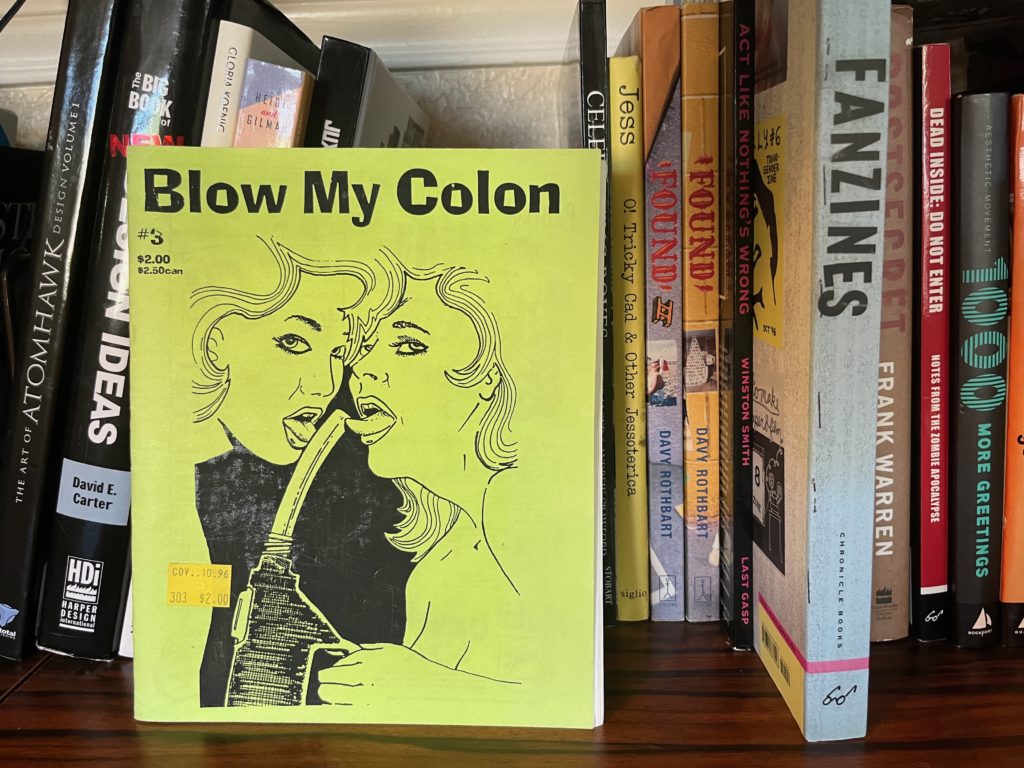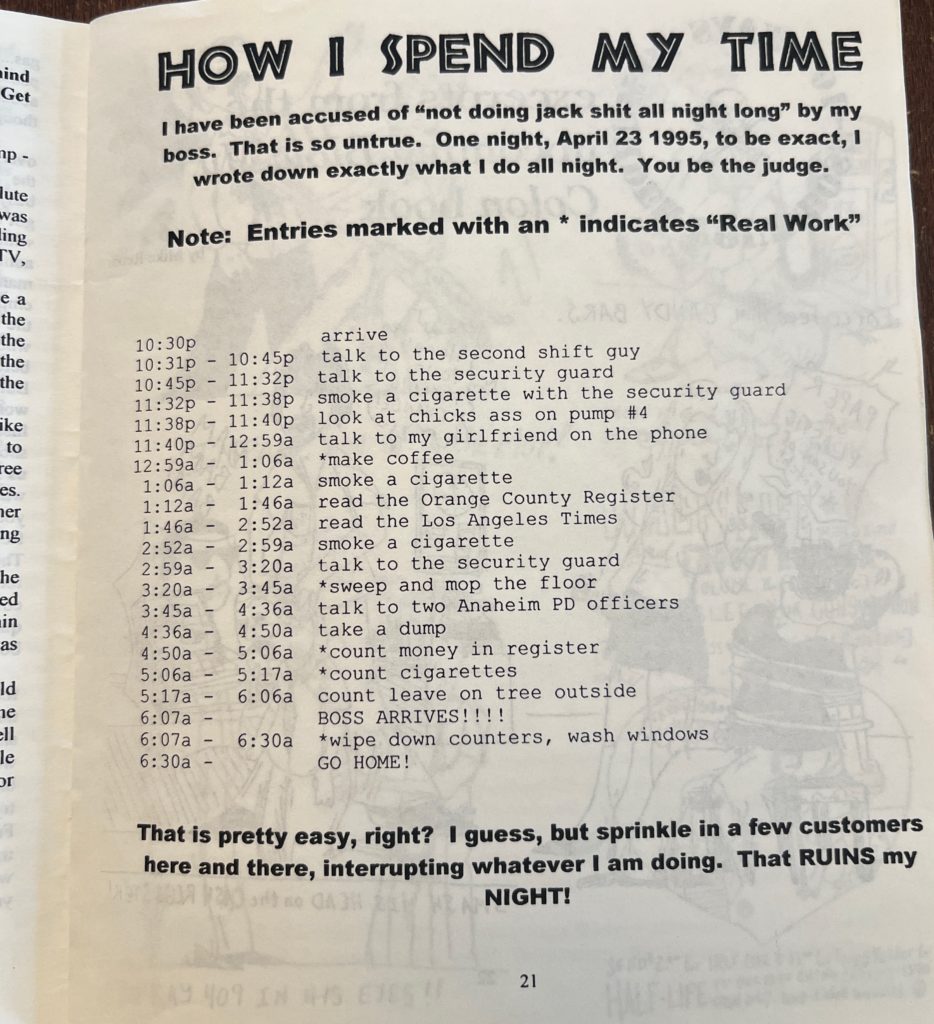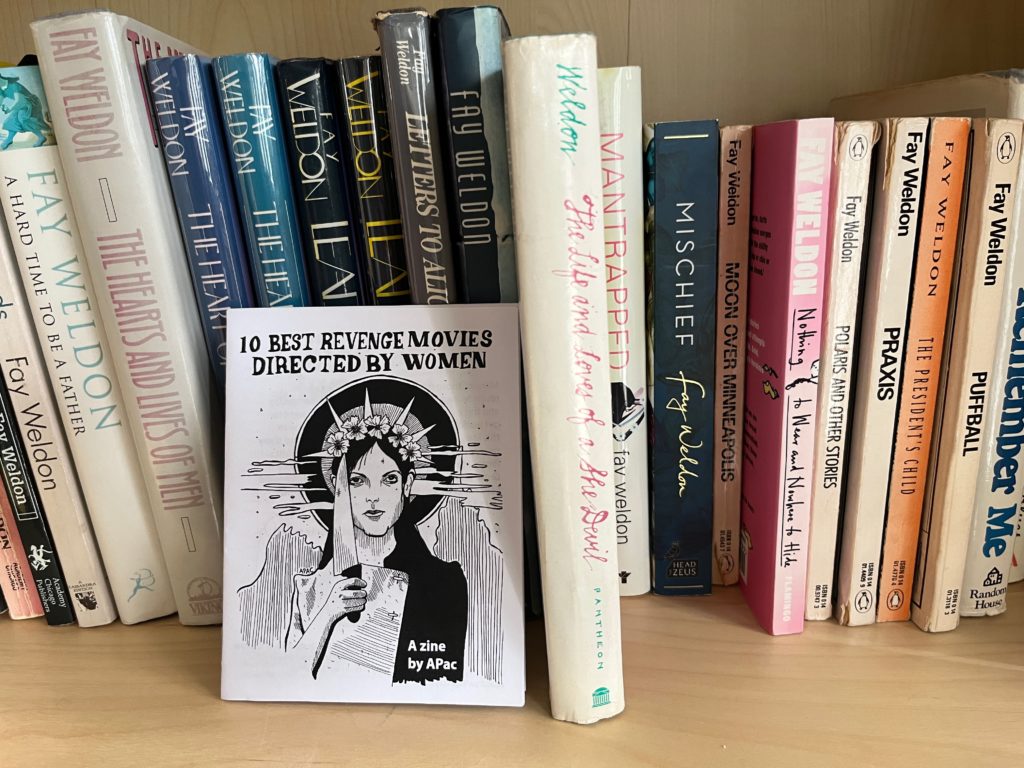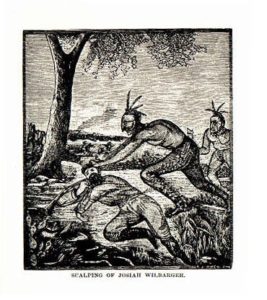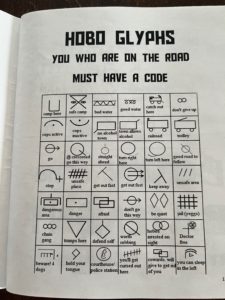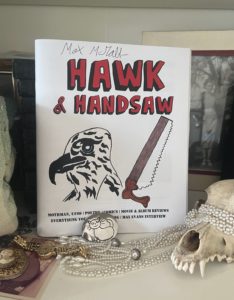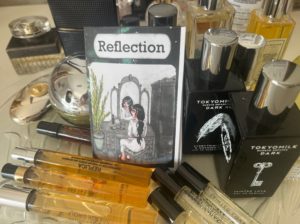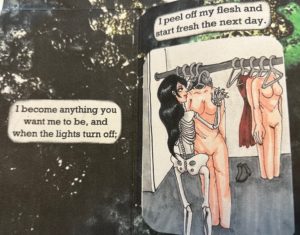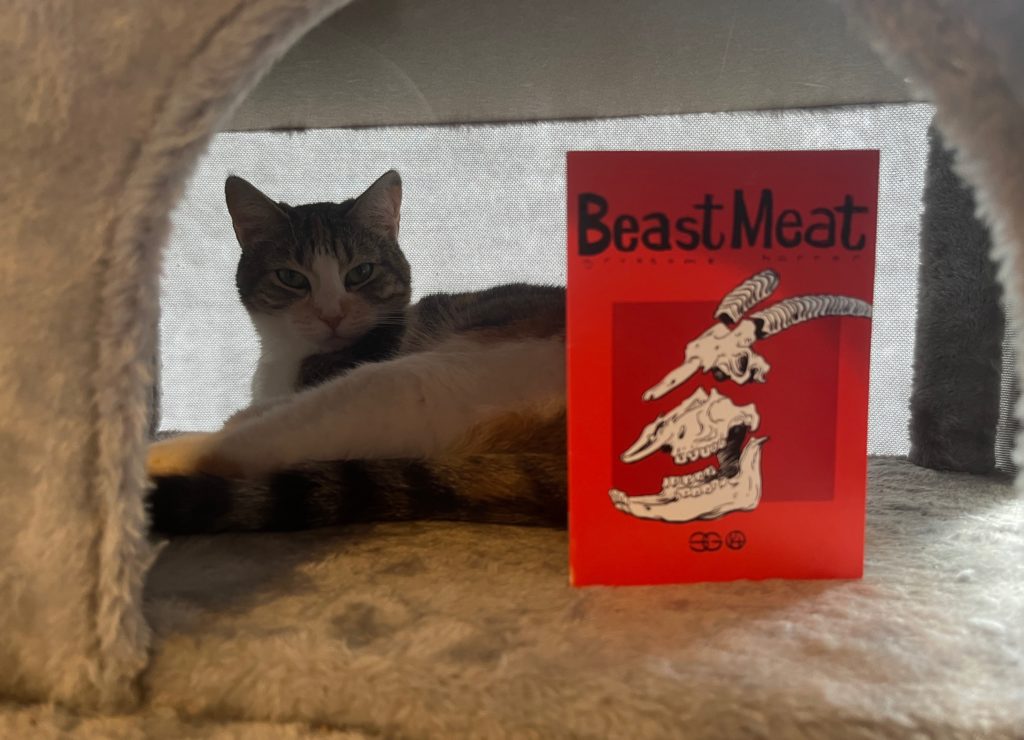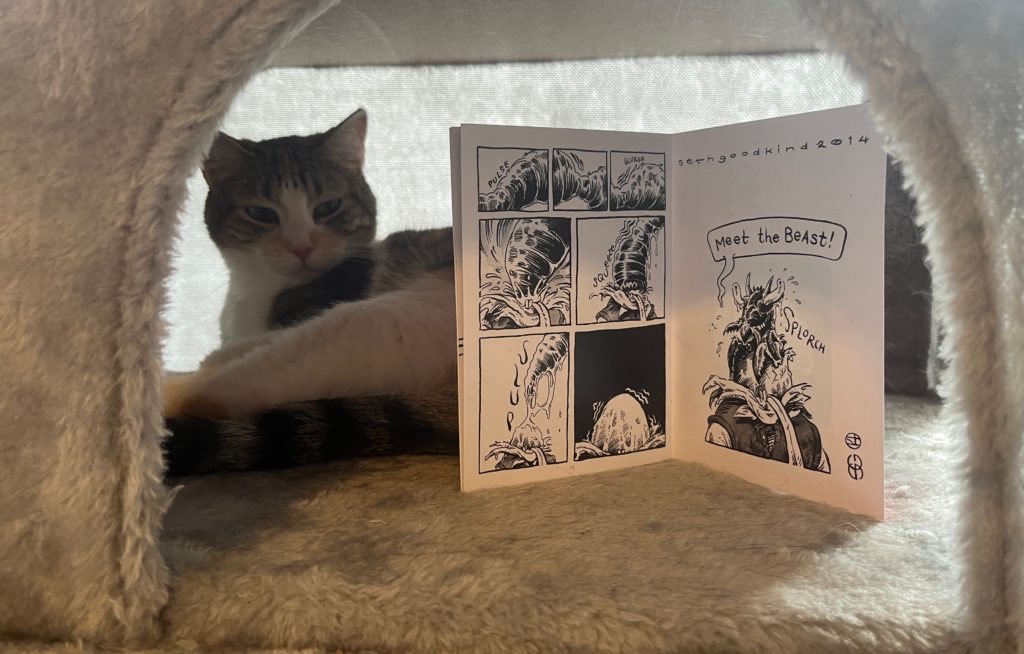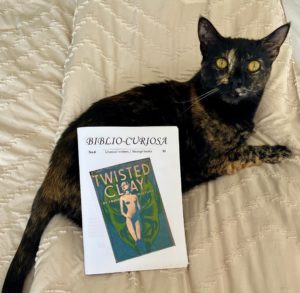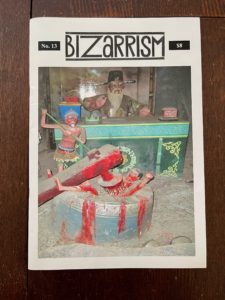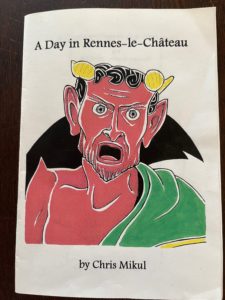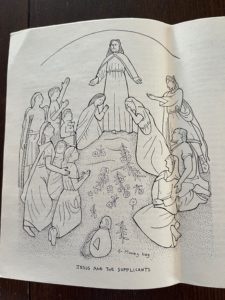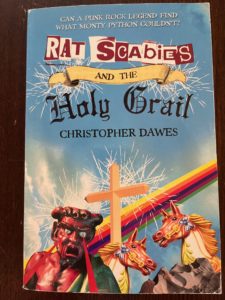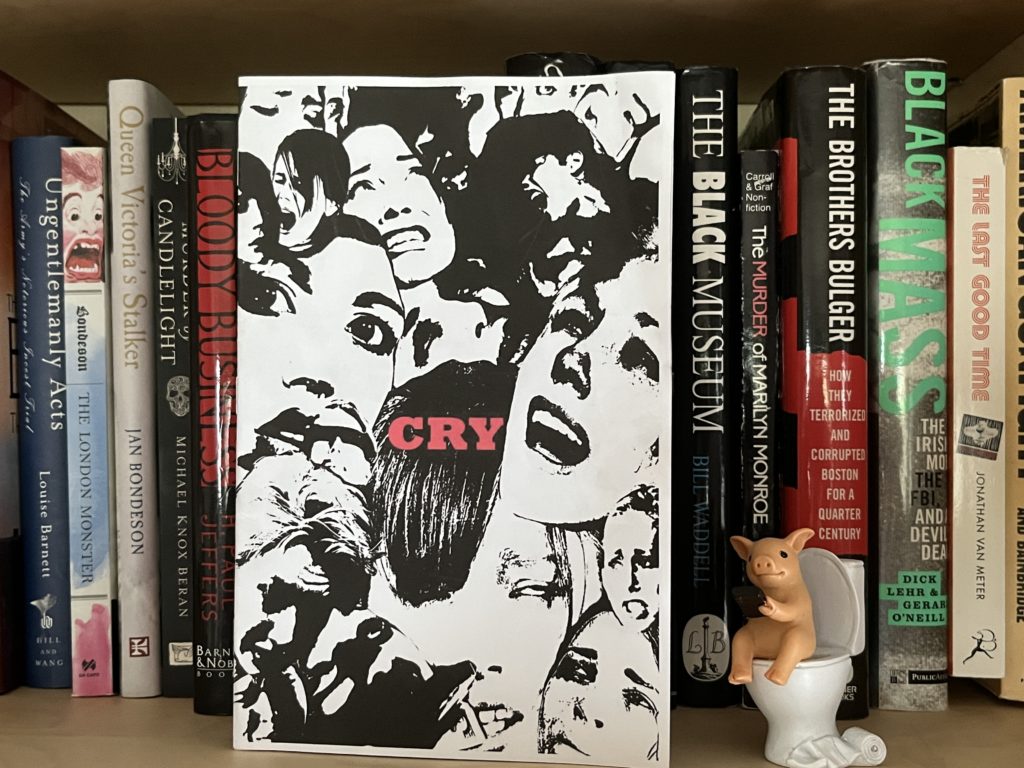For weeks, I tore up my office, closet and various bookshelves and could not find this ‘zine. I decided to discuss another ‘zine in it’s place, but before I truly committed I finally asked the long-suffering Mr. OTC to have a look. He sauntered into my office and five minutes later came out with Blow My Colon Issue 3 in his hands. I was relieved that he found it for a variety of reasons but not least among them is that in its place I had planned to discuss the 2020 compilation of The Deprogrammer, which is a hoot (and culturally interesting), but, in tackling it before another election involving Trump, I feared it would result in comments threatening to tar and feather or lynch me and I don’t have the time to run risk assessment. Maybe in 2026.
Blow My Colon Issue 3 holds few qualms in that regard because the target audience of this ‘zine are too tired to give a crap. BMC3 is the delightful “Clerks” edition. It was released in 1996, when Kevin Smith’s 1994 Clerks was still experiencing a lot of social cache and word of mouth. Back then movies could remain in the public consciousness for years. It was a simpler time. When I bought this, I had just quit managing a shoe store in Dallas, a job that left me feeling utter contempt for my fellow man and a new understanding of what causes workplace violence. I departed from that job with an angry nihilism combined with an almost-psychic ability to peg an aggressive asshole or condescending classist in an instant. At the end of the job, a thief could have come into the store with a Red Flyer wagon, dumped the contents of the cash register and half the purse displays into it, and walked out and I would have robotically told them to have a good day.
But this ‘zine reminded me that things could always be worse.
 This ‘zine is devoted to the men and women who staff gas stations and convenience stores, especially the night shift heroes who get to deal with drunks, bathroom shit-smearers*, and counting the cigarettes. Always counting cigarettes. Even with the massive change in technology we’ve experienced since 1996, these three issues still plague the lives of the convenience store clerk. This ‘zine tells the stories of the people who work these jobs and the derelicts and deviants who make their lives miserable.
This ‘zine is devoted to the men and women who staff gas stations and convenience stores, especially the night shift heroes who get to deal with drunks, bathroom shit-smearers*, and counting the cigarettes. Always counting cigarettes. Even with the massive change in technology we’ve experienced since 1996, these three issues still plague the lives of the convenience store clerk. This ‘zine tells the stories of the people who work these jobs and the derelicts and deviants who make their lives miserable.
And right about now I feel that I need to warn readers that if you are easily offended or angered, stop reading now.
I think you have to have cleaned a bathroom on Christmas Eve after a person with questionable hygiene had violent diarrhea while everyone else is at home, cozy and drinking eggnog, to fully understand the human experience. The stories of these brave men and women are sobering but mostly hilarious, though a bit gross at times.
For example, take Dave, who worked at a gas station in Erie, PA. He got the job just to stretch out his unemployment benefits, showed up absolutely stoned for every shift but was still praised for picking up the job details faster than anyone else in the store. The only way to make the job more challenging was to get even more stoned. When “massively high,” he’d work slowly, causing the line to pay to become very long.
That’s where it was helpful to wear a hat – keep that bill pointed down, never look the customer in the eye, laugh maniacally to yourself.
Dave also goes on at length about his coworkers and the more annoying customers who treated him like a therapist or vented their repellent political opinions at him.

Scoth from Indianapolis mentioned the three things that are present in almost all accounts of late night convenience store or gas station jobs. Free coffee, which a clerk must drink until their hearts began racing so quickly there was no discernible time between beats. Second, relentless theft, by employees and customers alike. Third, the cigarettes. Always counting cigarettes.
Josh from Oregon elegantly summed up the customer service experience:
Unless you’ve lived it, you can never fully understand the total impact of this hell on earth. I gained thirty pounds, an additional chin, and bags under my eyes that could pack a family of four. I worked graveyard so my bitterness is perfectly understandable.
He describes a terrible customer who threw milk at him and the utter indignity that waited for him:
He threw the milk jug at me on the way out. I don’t think the dude knew just what that meant to me. Not only was I forced to get up off my lazy ass and clean up the fuckin mess, but I was left with an over-ring. But worse than all the fucking pricks like that was counting those goddamed cigarettes every morning.
Adam from Santa Fe confirmed a lot of things many of us suspected about those in such service jobs:
Sometimes now I piss in the window cleaner. Then I watch all those dumb fucks wash their windows with it all day.
Even worse:
I spit everywhere. Coffee pots and ice machines and in the sandwiches we sell.
And, as always:
The worst thing about this fuck job though is counting the cigarettes.
Such jobs alter the way your brain works, as explained by Joe Gallo from New Jersey. One night when a seventeen-year-old girl accidentally drove through the front of the store, nearly taking out a line of people waiting to buy Lotto tickets, Joe’s reaction was interesting:
First thing I said: “Holy shit!” Next thing I said: “Awesome!”
Someone helpfully laid out their usual work tasks.
Also hilarious were the product reviews:
Waxie’s Gelled Rite-Away
Ok, this shit claims to remove “graffiti within 6 hours.” Sounds great if your graffiti is lipstick. Or erasable pen. Or a pencil, Or better yet, a piece of paper with “Chaka” sprayed on it, taped to the wall.
Since the clerk knew his boss would “shit a horse” if he saw some painted graffiti on the wall, he booked it to the stall with Waxie’s Gelled Rite-Away and when he was finished, the white paint was stripped down to the metal but the graffiti remained.
The ‘zine also includes a nice list of films from the eighties and nineties that depict the clerk experience, the weird gum you can find at convenience stores, shopping cart racing, a helpful list of ‘zines to read on the clock (featuring Fringe Ware Review, which is worth mentioning because I am almost certain I purchased this at the old FringeWare store on Guadalupe), and many humorous observations about cops.
And in case you were wondering, yes, the clerks frequently have sex in the store. Or at least they did in 1996. I suspect it is more difficult but if the coolers in back are not surveilled, you can probably bank on the fact that if you are waiting five minutes for a clerk to ring you up at 3:45 am, chances are he or she is in the cooler or a random storage closet expressing their love for their partner in a physical manner.
The nineties were the last time when people could be free to engage in compensatory retaliation. Yeah, yeah, spitting everywhere is unsanitary** and “you’re getting paid to work you communist” but I don’t care because being micromanaged with cameras on you from every angle as you spend half-an-hour with a religious fanatic Protestant, who is upset that you are selling Catholic glass canister candles, begging her to give you her credit card so you can charge her so she can leave, is worth a stolen six-pack or a furtive blow job under the counter. Cutting off the working person’s ability to blow off steam at work is probably why we as a nation are ready at a moment’s notice to kill each other. This ‘zine reminds me that I’m kind of old these days, but it was fun remembering the activity that radicalized me more than any politician or religious figure could – working the register.
Unfortunately finding a copy of this ‘zine will prove to be difficult but sometimes just knowing something this incredible exists is enough.
‘Zine September now comes to a close. I may do this again, especially if I get some good ‘zine recommendations. I also have some ‘zines I want to discuss in October. Except next month is ODDtober, where I hope to discuss creepy and frightening ‘zines, music, books and films.
*I once worked at a Half-Price Books. Best job of my life, I loved it but I was seasonal, and I would work there again in a moment, even taking into account the bathrooms. The women’s bathroom was a nightmare. Twice in my brief time there, someone smeared shit all over the ladies’ room stalls. The manager of the store was a rock star of a woman and and felt it was her responsibility to clean up when that happened but the second time I did it. I volunteered to do it because the manager had just learned she was pregnant. The ladies’ room also suffered from women not using their Diva cups with consideration for their fellow man, leaving period blood smeared on the doors and faucets, and one time, a defiant woman left huge blood clots clogging the bathroom sink.
But the best bathroom cleaning experience came from the men’s room. Someone had peed all over the wall outside of a regular stall, as well as all over the inside of the stall itself. As I was mopping up, I noticed sneaker prints on the back of the toilet – the store was old so the toilets were the sort you find in homes, with a tank with a lid and a regular flush mechanism. Smallish sneaker prints. I am not a forensics expert but I am reasonably sure a pre-teen boy stood atop the toilet tank and just peed all over the bathroom. I could not even be mad at it. I could just feel the degenerate glee that kid must have felt as he soaked the place in piss and wished him well in his future job in finance.
** If you’re eating gas station-prepared food anywhere but Buc-ees, some stoner spitting on your sandwich will be the least of your problems.
